
On beings and biomes–the Wolverine
By Dawnell Smith
Wolverines belong to winter.
They thrive in the cold, the mountains, the deep snow. They scramble up icy gullies, gallop across valleys and ridgelines, ramble up peaks over 10,000 feet.
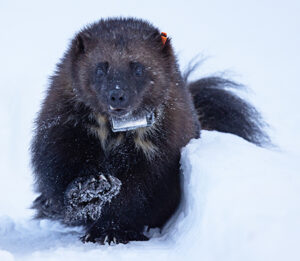
Researchers collared wolverines in Chugach State Park, Alaska, to learn about their movements, 2022-2023. By David Saalfeld, ADFG
They cache carrion and build dens in deep snow. They move across winter terrain like no other at a steady lope that can cover 20, 30 miles a day. Their fur insulates them so thoroughly that their body heat doesn’t melt the snow when they pause.
They cover ground with short squat legs that end in broad, thick paws with powerful claws. They seem too small for their reputation—15 to 40 pounds or more—but their temperament and attitude enlarge them considerably.
In the 2010 book “Wolverine Way” by Douglas Chadwick, he tells the story of researchers tracking wolverines in Glacier National Park and the elusive, scrappy characters who filled them with awe. Chapter one begins with an epigraph from the book “Lives of Game Animals: Vol. II, 1925-27” by Ernest Thompson Seton.
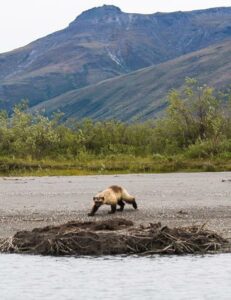
Wolverine on the Noatak river in Gates of the Arctic National Park. Photo by S. Behrns, NPS.
“The wolverine is a tremendous character… a personality of unmeasured force, courage, and achievement so enveloped in a mist of legend, superstition, idolatry, fear, and hatred, that one scarcely knows how to begin or what to accept as fact. Picture a weasel—and most of us can do that, for we have met the little demon of destruction, that small atom of insensate courage, that symbol of slaughter, sleeplessness, and tireless, incredible activity—picture that scrap of demoniac fury, multiply that mite by some fifty times, and you have the likeness of a wolverine.”
An indominable being
The wolverine falls within the weasel family, known as “gulo gulo” in Latin, or “gluttonous.” Despite or because they elude easy study and observation, they seem akin to mythical creatures like mermaids and Sasquatch. They resonate across cultures as indominable creatures with ferocious intelligence. They show up in human stories as pranksters, terrors, superheroes and troublemakers. They defy or disrupt assumptions.
How does a creature so small cover so much ground? Consume bones and teeth? Run off bears?
Australian actor Hugh Jackman of the “Wolverine” movie franchise initially studied wolves to prepare for his role. He thought the “wolverine” riffed off wolves. He had no idea wolverines existed.
The fact alone of the wolverine can conjure up visions. They scavenge like few others, detecting carcasses buried below snow and ice. They eat every part of the animal from flesh and tendons to hides, bones, teeth. They will defend carrion from much larger animals like grizzly bears.
They hunt mostly small animals like voles, squirrels and snowshoe hares, but have taken down caribou and moose.
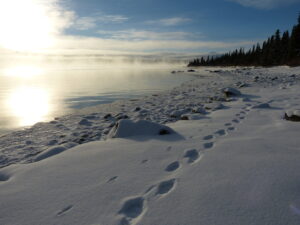
Mink and wolverine tracks at Telaquana Lake in Lake Clark National Park, 2012. Photo by J. Mills, NPS
Wolverines live in the alpine and boreal forests of northern Eurasia and North America. Good luck seeing them, though. A single wolverine requires hundreds of square miles of territory.
We don’t know how many wolverines live in Alaska, because population studies take time and money, and tracking and counting animals dispersed over so much area presents many challenges. Instead, those managing state and federal lands in Alaska assume that since hunters and trappers kill hundreds of wolverines every year, the population must be holding steady.
It’s foolish to ignore what’s happening in wolverine country, however. One troubling thing human activity does is whittle away wolverine terrain, box it up into smaller parts in between urban areas, industrial projects, and sprawl, and degrade and pollute the landscapes wolverines need to survive. Industrialization in turn drives climate change, which brings devastating results on the land.
Wolverines are winter animals, after all. They need the cold. Maternal dens require deep snowpack for birthing kits and for those kits to survive. (Cool fact: Wolverines may need to constantly cover the miles, but male wolverines will drop food by maternal dens when kits are still nursing and hang out with kits periodically, sometime traveling with older kits when hunting.)
Wildlife biologist Christi Heun once saw a wolverine from a helicopter while on a bear collaring project with the Alaska Department of Fish and Game. “We were seeing these tracks on top of all these tall, tall mountains and they were everywhere,” she said. “Spring had just sprung, and the ground squirrels were out, and you could see the wolverine’s tracks everywhere. Finally, we saw it just cruising over all these ridgetops.”
She hasn’t seen a wolverine since, but the animal remains in her field of care. These days she works for one of our clients and partners, Defenders of Wildlife, to protect wolverines and the places they live.
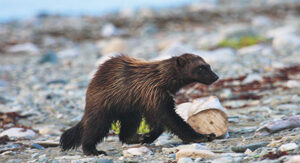
Wolverine at McNeil River in Alaska. Photo by Drew Hamilton
“Wolverines are really good indicator species,” she said. “If you have habitat that’s really big and not industrialized, you’re going to see wolverines.”
In other words, seeing or not seeing wolverines would be a good indicator about how environmental changes are impacting the larger ecosystem. Wolverines would be among the first species affected by changes brought on by things like an industrial mining road, oil project, or loss of snowpack due to climate change.
Moving is the thing
Wolverines need vast areas and certain conditions to survive (snowpack, hundreds of square miles to roam, food sources, no human industry), and their very nature involves constant movement through landscapes. This movement over the vast areas of land and the corridors that connect these landscapes allows them to interact with each other. It allows their young to establish new territories. Movement can also help them adapt to climate change.
To sustain this constant movement, wolverines need big areas and corridors between them.
When Heun helped draft comments in response to a proposal to rescind longtime protection for 28 million acres of lands protected by the Alaska Native Claims Settlement Act, she explained what’s at stake for wolverines.
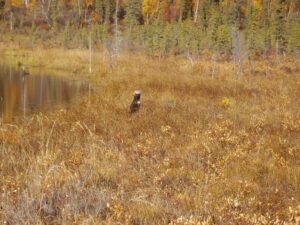
Wolverine stands in the grass in Gates of the Arctic National Park. NPS photo
These animals require unhindered movement in order to adapt to melting permafrost, declining snowpack, and changes to plant life, the comment letter explained. “When habitat is fragmented by barriers (e.g., human infrastructure) wildlife are unable to access the extent of their needed range which can also inhibit major lifecycle events such as breeding, birthing, rearing of young, foraging, or migrating. Ultimately, challenges to wildlife species anticipated with climate change would be highly exacerbated if habitat connectivity is lost.”
This has already happened in the Lower 48 states, where wolverines are now designated as threatened due to the ongoing impacts of climate change and habitat fragmentation and degradation.
Climate change has impacted Alaska, and specifically the Arctic, at far higher rates than other areas of the world.
Wolverines once lived across the northern Lower 48 states from Washington to Montana, south down the Pacific Coast range and Sierras, down the Rockies, and were even seen at the Great Lakes and New England. Today they mostly live in Alaska and remote areas of Montana, Idaho, and Wyoming in the United States.
Here in Alaska, wolverine pelts are often traded, gifted, and prized by Alaska Native people for their warmth. The first time I saw a friend wearing a fur parka with wolverine claws down the neckline, I could not stop looking at it. A family member had made and given her the traditional coat.
Those claws seemed to gift her with power.
What wolverines ask of us
For me, who has yet to see a wolverine on the land or mountains, but who has a tattoo of one that morphs into a mermaid, these animals exist in a liminal space between what’s real and what’s mythical. They manifest the be-ing beyond human beings, and an experience of the Earth we share but cannot wholly know.
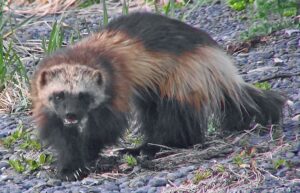
Wolverine still image from video taken in Icy Bay, Prince William Sound, 2012, by Wayne Hall
In that Chadwick book about studying wolverines, he talks about the wooden live traps they used to capture and then attach tracking collars to wolverines. They would need to get to the trap quickly since the animals could bite themselves out the log traps. Researchers would lift the trap an inch and peer in with a flashlight to make sure they caught a full-grown wolverine and not a sub-adult or a lynx or coyote. It always feels dicey opening that trap.
A wolverine would interpret “any opening of the lid as an opportunity to rush at the invader,” he wrote, “to rage and roar and drip saliva and snap his formidable teeth, sending the message: I will rip you open if I can, and if I can’t, I will die before I yield.”
Wolverines don’t need us to show them how to survive. They need us to get out of their way.
This is the second in our “Beings and biomes” series. You can find previous articles below:


